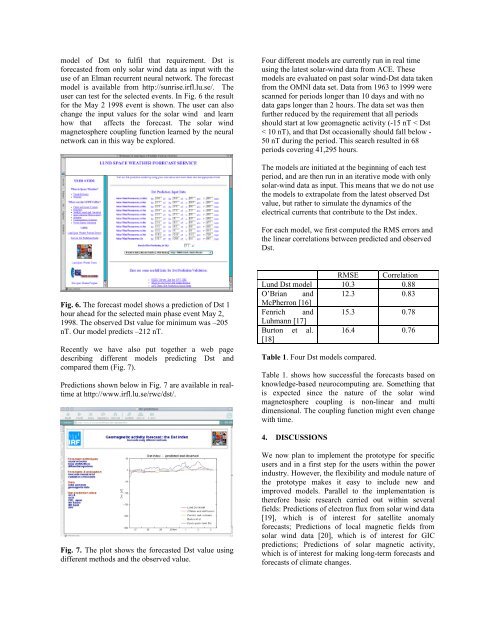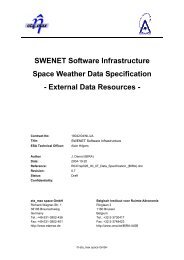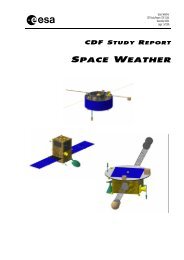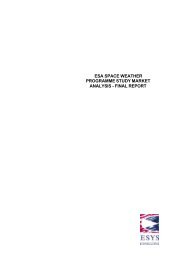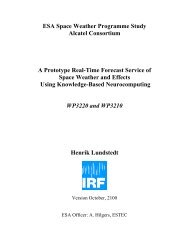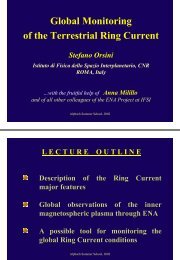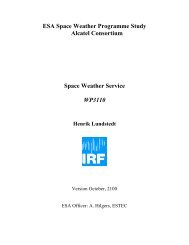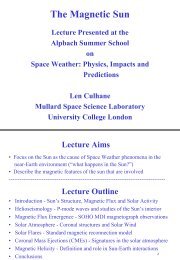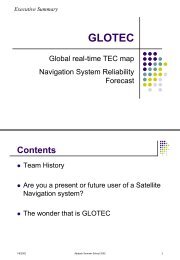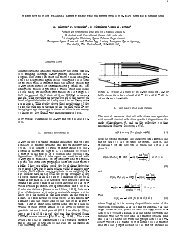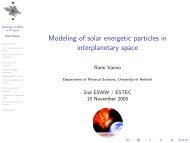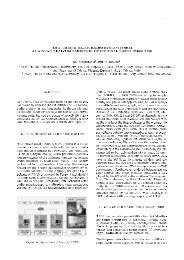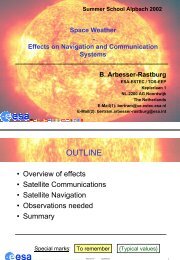forecasting space weather and effects using knowledge-based ...
forecasting space weather and effects using knowledge-based ...
forecasting space weather and effects using knowledge-based ...
Create successful ePaper yourself
Turn your PDF publications into a flip-book with our unique Google optimized e-Paper software.
model of Dst to fulfil that requirement. Dst is<br />
forecasted from only solar wind data as input with the<br />
use of an Elman recurrent neural network. The forecast<br />
model is available from http://sunrise.irfl.lu.se/. The<br />
user can test for the selected events. In Fig. 6 the result<br />
for the May 2 1998 event is shown. The user can also<br />
change the input values for the solar wind <strong>and</strong> learn<br />
how that affects the forecast. The solar wind<br />
magnetosphere coupling function learned by the neural<br />
network can in this way be explored.<br />
Fig. 6. The forecast model shows a prediction of Dst 1<br />
hour ahead for the selected main phase event May 2,<br />
1998. The observed Dst value for minimum was –205<br />
nT. Our model predicts –212 nT.<br />
Recently we have also put together a web page<br />
describing different models predicting Dst <strong>and</strong><br />
compared them (Fig. 7).<br />
Predictions shown below in Fig. 7 are available in realtime<br />
at http://www.irfl.lu.se/rwc/dst/.<br />
Fig. 7. The plot shows the forecasted Dst value <strong>using</strong><br />
different methods <strong>and</strong> the observed value.<br />
Four different models are currently run in real time<br />
<strong>using</strong> the latest solar-wind data from ACE. These<br />
models are evaluated on past solar wind-Dst data taken<br />
from the OMNI data set. Data from 1963 to 1999 were<br />
scanned for periods longer than 10 days <strong>and</strong> with no<br />
data gaps longer than 2 hours. The data set was then<br />
further reduced by the requirement that all periods<br />
should start at low geomagnetic activity (-15 nT < Dst<br />
< 10 nT), <strong>and</strong> that Dst occasionally should fall below -<br />
50 nT during the period. This search resulted in 68<br />
periods covering 41,295 hours.<br />
The models are initiated at the beginning of each test<br />
period, <strong>and</strong> are then run in an iterative mode with only<br />
solar-wind data as input. This means that we do not use<br />
the models to extrapolate from the latest observed Dst<br />
value, but rather to simulate the dynamics of the<br />
electrical currents that contribute to the Dst index.<br />
For each model, we first computed the RMS errors <strong>and</strong><br />
the linear correlations between predicted <strong>and</strong> observed<br />
Dst.<br />
RMSE Correlation<br />
Lund Dst model 10.3 0.88<br />
O’Brian <strong>and</strong> 12.3 0.83<br />
McPherron [16]<br />
Fenrich <strong>and</strong> 15.3 0.78<br />
Luhmann [17]<br />
Burton<br />
[18]<br />
et al. 16.4 0.76<br />
Table 1. Four Dst models compared.<br />
Table 1. shows how successful the forecasts <strong>based</strong> on<br />
<strong>knowledge</strong>-<strong>based</strong> neurocomputing are. Something that<br />
is expected since the nature of the solar wind<br />
magnetosphere coupling is non-linear <strong>and</strong> multi<br />
dimensional. The coupling function might even change<br />
with time.<br />
4. DISCUSSIONS<br />
We now plan to implement the prototype for specific<br />
users <strong>and</strong> in a first step for the users within the power<br />
industry. However, the flexibility <strong>and</strong> module nature of<br />
the prototype makes it easy to include new <strong>and</strong><br />
improved models. Parallel to the implementation is<br />
therefore basic research carried out within several<br />
fields: Predictions of electron flux from solar wind data<br />
[19], which is of interest for satellite anomaly<br />
forecasts; Predictions of local magnetic fields from<br />
solar wind data [20], which is of interest for GIC<br />
predictions; Predictions of solar magnetic activity,<br />
which is of interest for making long-term forecasts <strong>and</strong><br />
forecasts of climate changes.


